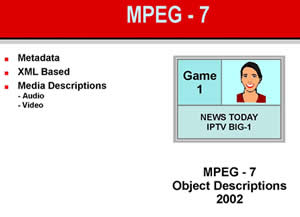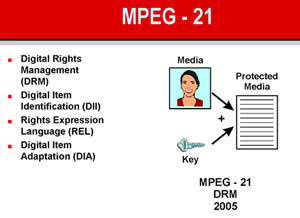Difference between MPEG7 and MPEG21
Key difference: MPEG stands for the Moving Picture Experts Group. MPEG7 was released in 2002 and is a Multimedia content description standard. It is different that the previous formats, as unlike MPEG-1, MPEG-2 and MPEG-4, it does not deal with coding of moving pictures and audio. In fact, MPEG7 allows the embedding of metadata information into audio and video files. MPEG21 was released in the year 2001 and was designed to define an open framework for multimedia applications. It is a standard that defines the description of content, as well as processes for accessing, searching, storing and protecting the copyrights of content.
 MPEG stands for the Moving Picture Experts Group. It is a working group of experts that was formed in 1988 by ISO and IEC. It was a joint initiative between Hiroshi Yasuda of the Nippon Telegraph and Telephone and Leonardo Chiariglione. Chiariglione has served as the group’s Chair since the group’s inception.
MPEG stands for the Moving Picture Experts Group. It is a working group of experts that was formed in 1988 by ISO and IEC. It was a joint initiative between Hiroshi Yasuda of the Nippon Telegraph and Telephone and Leonardo Chiariglione. Chiariglione has served as the group’s Chair since the group’s inception.
The aim of MPEG was to set standards for audio and video compression and transmission. By 2005, the group has grown to include approximately 350 members per meeting from various industries, universities, and research institutions.
The standards as set by MPEG consist of different Parts. Each part covers a certain aspect of the whole specification. MPEG has standardized the following compression formats and ancillary standards:
- MPEG-1 (1993): Coding of moving pictures and associated audio for digital storage media at up to about 1.5 Mbit/s (ISO/IEC 11172). Designed to compress VHS-quality raw digital video and CD audio without excessive quality loss, making video CDs, digital cable/satellite TV and digital audio broadcasting (DAB) possible. It includes the popular MPEG1 Audio Layer III (MP3) audio compression format.
- MPEG-2 (1995): Generic coding of moving pictures and associated audio information (ISO/IEC 13818). Describes a combination of lossy video compression and lossy audio data compression methods, which permit storage and transmission of movies using currently available storage media and transmission bandwidth.
- MPEG-3: Dealt with standardizing scalable and multi-resolution compression and was intended for HDTV compression but was found to be redundant and was merged with MPEG2.
- MPEG-4 (1999): Coding of audio-visual objects. Includes compression of AV data for web (streaming media) and CD distribution, voice (telephone, videophone) and broadcast television applications. It includes the MPEG-4 Part 14 (MP4).
- MPEG-7 (2002): Multimedia content description interface. Not a standard which deals with the actual encoding of moving pictures and audio, like MPEG1, MPEG2 and MPEG4. It uses XML to store metadata, and can be attached to timecode in order to tag particular events, or synchronize lyrics to a song.
- MPEG-21 (2001): Multimedia framework. It is aimed at defining an open framework for multimedia applications. Based on definition of a Digital Item and users interacting with Digital Items.
MPEG7 was released in 2002 and is a Multimedia content description standard. It is different that the previous formats, as unlike MPEG-1, MPEG-2 and MPEG-4, it does not deal with coding of moving pictures and audio. In fact, MPEG7 was designed to standardize: a set of description schemes and descriptors; a language to specify these schemes, called the Description Definition Language (DDL); and a scheme for coding the description.
MPEG7 allows the embedding of metadata information into audio and video files. Hence, the audio and video files can be searched and indexed based on the information about the content instead of searching the actual content bitstream. MPEG7 does this by using XML to store the metadata. It can then be attached to timecode in order to tag particular events, or synchronize lyrics to a song. An advantage to using XML to store the metadata is that XML is universal. Hence, MPEG7 can be read my most existing tools that support XML parsing.
MPEG7 is not generally used today by the average user and adoption has been slow. However, Wikipedia lists the many applications and application domains that can benefit from the format, including:
- Digital library: Image/video catalogue, musical dictionary.
- Multimedia directory services: e.g. yellow pages.
- Broadcast media selection: Radio channel, TV channel.
- Multimedia editing: Personalized electronic news service, media authoring.
- Security services: Traffic control, production chains, etc.
- E-business: Searching process of products.
- Cultural services: Art-galleries, museums, etc.
- Educational applications.
- Biomedical applications.
 MPEG21 was released in the year 2001 and was designed to define an open framework for multimedia applications. Unlike the previous MPEG standards, such as MPEG1, MPEG2 and MPEG4, MPEG21 does not describe compression coding methods. Instead, it is a comprehensive standard framework for networked digital multimedia. It is a standard that defines the description of content, as well as processes for accessing, searching, storing and protecting the copyrights of content.
MPEG21 was released in the year 2001 and was designed to define an open framework for multimedia applications. Unlike the previous MPEG standards, such as MPEG1, MPEG2 and MPEG4, MPEG21 does not describe compression coding methods. Instead, it is a comprehensive standard framework for networked digital multimedia. It is a standard that defines the description of content, as well as processes for accessing, searching, storing and protecting the copyrights of content.
The MPEG21 was based on two essential concepts: the definition of a Digital Item and users interacting with Digital Items. Digital Items can be considered the kernel of the Multimedia Framework. MPEG21 provides a framework in which one user interacts with another by means of a Digital Item. Hence, MPEG21 defines ‘the technology needed to support users to exchange, access, consume, trade or manipulate Digital Items in an efficient and transparent way.’
MPEG21 defines the storage of a Digital Item in a file format based on the ISO base media file format. This allows some or all of the Digital Item's ancillary data to be saved in the same file. This data can include movies, images or other non-XML data.
MPEG21 also includes a Rights Expression Language (REL) standard and a Rights Data Dictionary. The REL standard is a means of managing restrictions for digital content usage. The file extension for MPEG21 is .m21 or .mp21 and MIME type application/mp21.
Image Courtesy: althos.com









Add new comment